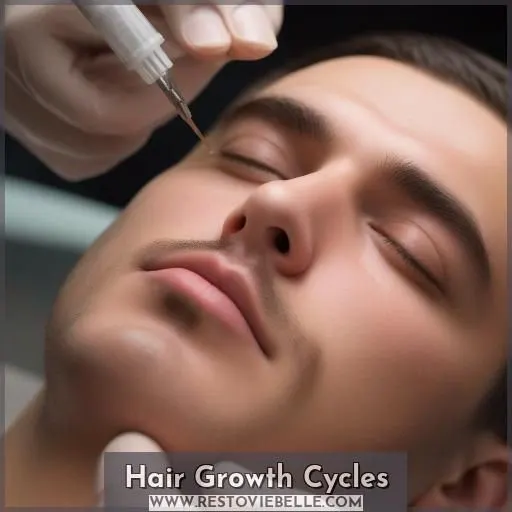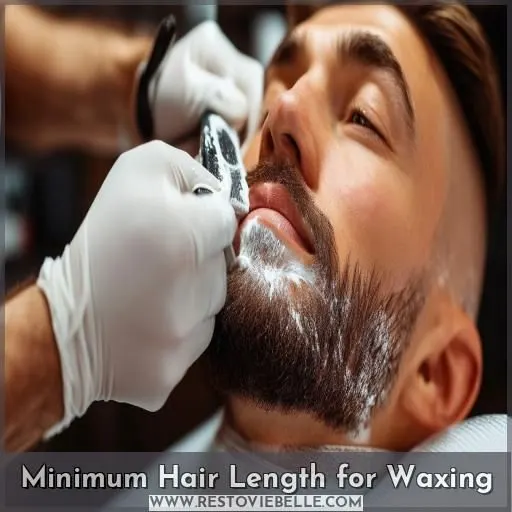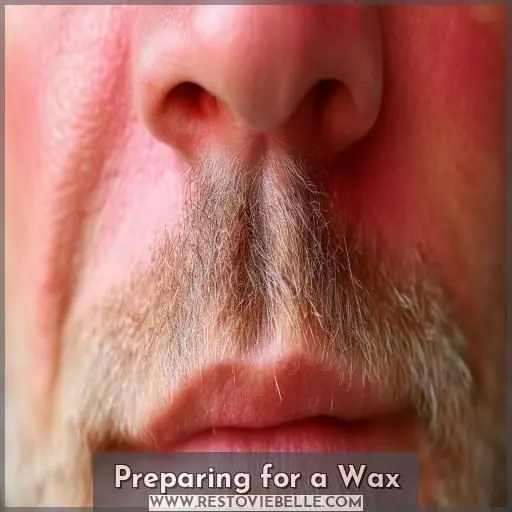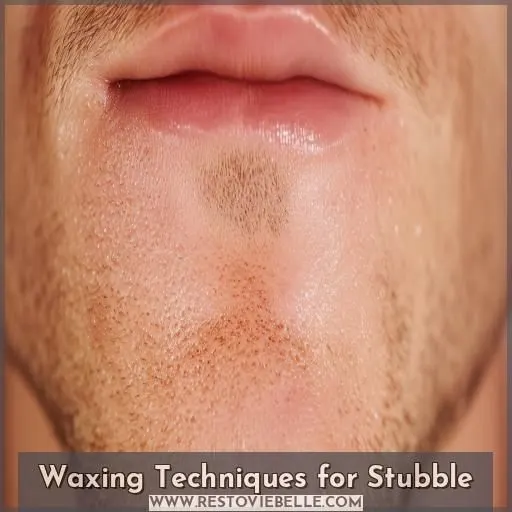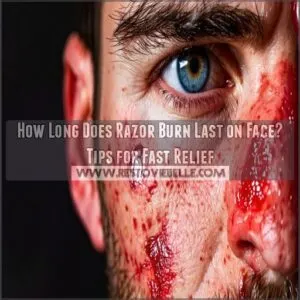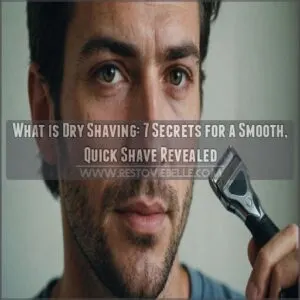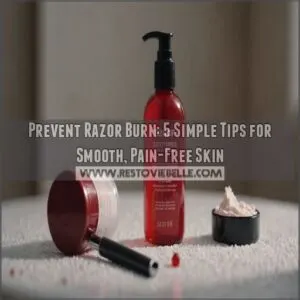This site is supported by our readers. We may earn a commission, at no cost to you, if you purchase through links.
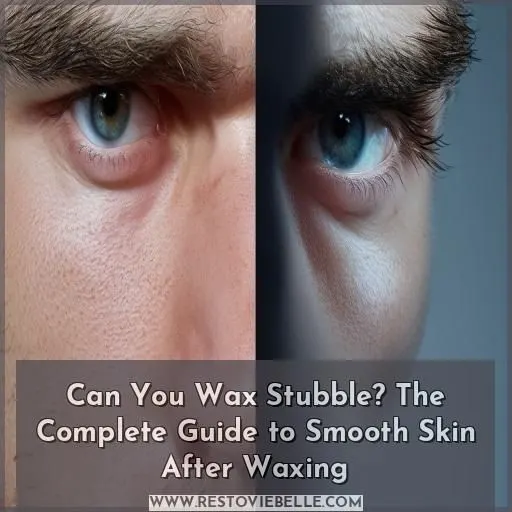 Yes, you can absolutely wax stubble!
Yes, you can absolutely wax stubble!
With the right preparation and techniques, even the shortest hairs can be removed for smooth, enviable skin.
The key is proper exfoliation a few days before and trimming to around 1/4 inch for effective wax adhesion.
During the wax, use hot wax in small sections, applied in the hair’s direction then pulled off against it.
Be sure to moisturize after for soothed skin.
Follow these steps, and you’ll be stubble-free in no time.
Keep reading to discover more tips for finer regrowth with each wax.
Table Of Contents
- Key Takeaways
- Can You Wax Stubble?
- Hair Growth Cycles
- Minimum Hair Length for Waxing
- Preparing for a Wax
- Waxing Techniques for Stubble
- Post-Wax Care for Stubble
- Benefits of Waxing Stubble
- When to Reschedule a Wax
- Frequently Asked Questions (FAQs)
- Can waxing get rid of stubble?
- Can you wax short stubble?
- What happens if hair is too short to wax?
- Can I wax if I just shaved?
- How long after shaving can you wax?
- Are there special waxes for short hair?
- Can you wax during your menstrual cycle?
- What causes ingrown hairs after waxing stubble?
- Are there permanent hair removal options besides waxing?
- Conclusion
Key Takeaways
- Don’t let those stubborn stubbles keep you from feeling silky-smooth! With the right waxing techniques, even the shortest hairs can be banished for enviable skin.
- Say goodbye to ingrown nightmares! Waxing stubble not only removes the entire hair from the root, but it also weakens those pesky follicles over time – leading to finer, softer regrowth. It’s a win-win!
- Patience is key, my friend. If your hair’s too short for the wax to grab onto, don’t force it. Take a breather, let those strands grow out a little bit, and come back refreshed for a smoother sailing experience.
- Communication is crucial! Don’t be shy about chatting with your waxing expert – they’re there to ensure you get the best results possible. Share your concerns, ask questions, and trust their expertise to guide you through the stubble-slaying process.
Can You Wax Stubble?
Yes, you can wax stubble. Hair needs to be around 1/4 inch long for waxing to effectively remove it from the roots. With proper preparation and technique, waxing stubble can remove hair and lead to smoother regrowth.
Hair Growth Cycles
You’ve probably noticed your hair grows in cycles—it sprouts, gets longer, then sheds before repeating. This cyclical growth occurs in three stages: anagen (growth), catagen (transition), and telogen (resting).
Hair removal disrupts these cycles, causing follicle damage that can lead to finer, sparser regrowth. Understanding these natural patterns empowers you to work with, rather than against, your hair’s growth for smoother, longer-lasting results.
Minimum Hair Length for Waxing
You can wax even short stubble with the right techniques. Hard wax and sugaring are two methods that allow waxing of very short hair, provided you visit an experienced technician.
Hard Wax for Short Hair
You can wax stubble using hard wax! Unlike soft wax, hard wax grips even the shortest hairs for efficient removal. Here’s how it’s done:
- The waxologist applies a thick layer of hot hard wax over the stubble
- Once cooled, the wax "shell" is gripped and removed in the direction of hair growth
- Hard wax minimizes skin trauma while grabbing stubborn short hairs
Hard wax is ideal for male waxing and coarse hair types. With proper technique, your skin will be left smooth after waxing. Hard wax may be more uncomfortable but delivers superior results on stubble.
Sugaring for Short Hair
If waxing isn’t an option for your stubble, sugaring could be the solution. Sugaring is a gentle hair removal method using a gel or paste made from sugar, water, and lemon.
The gel requires around 1/4-inch hair growth, while the paste can remove hair as short as 1/16-inch. However, the paste technique is trickier and best left to skilled technicians.
The sugaring paste is applied against the hair’s growth, then flicked off in the direction of growth. With proper technique, sugaring can effectively remove even the shortest, coarsest stubble, leaving you with smooth, soft skin.
Its efficacy depends on your technician’s expertise, so research reputable sugaring salons.
Preparing for a Wax
To prepare for waxing, it’s important to exfoliate your skin a few days beforehand to remove dead skin cells and allow the wax to grip the hair more effectively. If you have significant hair growth, trim the area with clean, disinfected scissors to a length of around 1/4 inch, as waxing stubble can lead to irritation and ingrown hairs.
Exfoliation
Exfoliating your skin before a wax is essential – it removes dead cells, allowing the wax to grip hair properly.
Use an exfoliating pad or gentle scrub a day or two beforehand.
Avoid harsh exfoliating acids that could irritate freshly waxed skin.
Proper exfoliation extends the longevity of your smooth results by preventing ingrown hairs.
Don’t overdo it – exfoliating too frequently or too harshly can cause inflammation, defeating the purpose.
When in doubt, ask your waxologist for their recommended exfoliation techniques and product suggestions.
Trimming
To achieve desirable results, trimming prior to waxing is essential. Here are five guidelines for appropriate trimming:
- Utilize sanitized scissors or trimmers to prevent infection
- Trim hair to 1⁄4 – 1⁄2 inch for effective wax adhesion
- Trim with the direction of hair growth for a neat finish
- Trim sensitive areas attentively and with accuracy
- Maintain hygiene by cleaning tools after each use
With trimming, you control the waxing process, minimizing discomfort and securing supple, long-lasting results. Consider it the precursor to your velvety, hairless haven – a fundamental step that sets the foundation for waxing perfection.
Waxing Techniques for Stubble
For waxing stubble or very short hair, use hot wax applied in small sections rather than cold wax strips. Apply the wax in the direction of hair growth, then pull it off in the opposite direction using firm, deliberate motions.
Hot Wax Application
You’ll need high-quality hot wax that’s been properly heated to the ideal temperature.
The wax must have a smooth, spreadable consistency—neither too thick nor runny.
Apply the wax in the direction of hair growth using firm, confident strokes.
Work in small sections, slightly overlapping the wax.
The angle of application matters; try pulling the skin taut as you wax.
Once applied, swiftly rip off the wax in the opposite direction of hair growth using one clean motion.
Don’t hesitate—remove it decisively.
With the right waxing angles, temperature, consistency, application speed, and removal technique, you’ll banish stubble successfully.
Smaller Sections
To effectively wax stubble, break the area into smaller sections. This allows you to precisely target the short, stubborn hairs for better removal.
Work in sections of 1-2 inches at a time, applying hot wax and pulling against the hair growth. You’ll need a steady hand and patience, but taking it slow prevents irritation and guarantees a smoother finish.
For pain management, use a numbing cream beforehand.
Afterward, soothe skin with a gentle moisturizer designed to prevent ingrown hairs and bumps.
Trust the process—with proper technique and quality wax, you can achieve smooth results even on stubble.
Post-Wax Care for Stubble
After waxing stubble, soothe your skin by applying a gentle, fragrance-free moisturizer. To prevent irritation, avoid exfoliating, hot water, and tight clothing for 24-48 hours while your skin recovers.
Soothing Skin
After waxing stubble, your skin will likely feel irritated and sensitive.
Soothe it with gentle, moisturizing techniques. Cleanse with a mild soap and cool water to calm redness. Avoid scrubbing or exfoliating for 24 hours.
Then, apply a fragrance-free lotion containing aloe vera or chamomile to hydrate and reduce inflammation. For extra relief, chill the moisturizer in the fridge beforehand.
If ingrown hairs develop, use a warm compress and treat with salicylic acid pads.
With proper aftercare, your skin will feel refreshed post-wax.
Preventing Irritation
After soothing your skin, you’ll want to prevent further irritation.
Avoid hot showers or baths for 24-48 hours as they can inflame the area. Stick to gentle, fragrance-free moisturizing products to keep skin calm.
If redness or bumps appear, try aloe vera gel or an over-the-counter hydrocortisone cream.
Avoid tight clothing that rubs against sensitized skin. Triggers like chlorine pools, saunas, or intense sun exposure are off-limits until your skin has fully recovered.
With a little TLC, any post-wax irritation should clear up within a few days.
Benefits of Waxing Stubble
Waxing your stubble can result in finer, softer regrowth over time as the hair follicles become weakened. It also helps minimize ingrown hairs, which are common with shaving, because waxing removes the entire hair from the root.
Finer Regrowth
When waxing stubble hair, you’ll be thrilled by the finer regrowth that follows. Regular waxing disrupts the hair growth cycle, causing new strands to emerge:
- Finer
- Softer
- Sparser
This gradual improvement occurs because waxing removes the entire hair follicle, disturbing its anchoring within the skin. Don’t worry about sensitivity – the benefits outweigh any initial irritation from stubble removal. With proper technique and aftercare, waxing even short hairs prevents thicker, coarser regrowth over time.
Fewer Ingrown Hairs
Waxing stubble reduces ingrown hairs, leading to smoother, healthier skin. By removing hair from the root, waxing prevents hairs from curling back into the skin. Additionally, the exfoliation process during waxing clears pores, allowing new hair to grow freely. Here’s a quick guide:
| Step | Action |
|---|---|
| 1 | Exfoliate before waxing |
| 2 | Use high-quality wax |
| 3 | Wax in the direction of hair growth |
| 4 | Moisturize after waxing |
| 5 | Avoid harsh scrubs post-wax |
Follow these steps, and you’ll bid farewell to pesky ingrown hairs, embracing a smooth, radiant complexion.
When to Reschedule a Wax
If your skin has a sunburn or rash, reschedule your wax to avoid irritation.
Similarly, if your hair is too short, the waxing salon may refuse service or the results won’t be satisfactory.
If you’re using prescription retinol or exfoliating acids, consult your dermatologist first as waxing could cause excessive irritation or disrupt their effectiveness.
Listen to your body and the professionals – a smooth, irritation-free experience requires proper timing and preparation.
Frequently Asked Questions (FAQs)
Can waxing get rid of stubble?
Like polishing a granite countertop, waxing can indeed eradicate stubble. With consistent treatments, your skin becomes a smooth canvas, revealing its natural radiance.
Can you wax short stubble?
Yes, you can wax short stubble using hard wax. Salons might require hair at least 1⁄4 inch long, but many technicians can effectively remove stubble with proper technique. Discuss your needs and their methods for removing stubbly hair during your consultation.
What happens if hair is too short to wax?
Even if you hoped to wax stubble, the salon will refuse. Hair needs to be around 1/4 inch for effective waxing. Be patient and wait for growth before your next appointment.
Can I wax if I just shaved?
No, you can’t wax freshly shaved skin. Waxing requires some hair growth, typically around 1/4 inch, for effective removal. Trying to wax stubble will only lead to irritation and discomfort. Let your hair grow out a bit before your next waxing appointment.
How long after shaving can you wax?
70% of waxers wait too long between waxing. You’ll want to wait 10-14 days after shaving before waxing for satisfactory results – that’s just enough stubble for an effective wax.
Are there special waxes for short hair?
Yes, salons often use hard waxes like Cirepil or thick gel waxes for removing shorter, stubbly hair. The wax adheres better, allowing more hairs to be pulled from their roots. However, technique is essential for stubble—it requires a skilled waxer.
Can you wax during your menstrual cycle?
Remember that day your flow surprised you? Well, it’s best to avoid waxing during your period – the increased sensitivity can make it too painful. Wait until your cycle ends for a smoother experience.
What causes ingrown hairs after waxing stubble?
You could get ingrown hairs from waxing stubble due to the sharp tips penetrating the skin. But exfoliating regularly and using ingrown hair treatments can minimize this risk.
Are there permanent hair removal options besides waxing?
Yes, there are permanent hair removal options like laser hair removal and electrolysis that can eliminate stubble and regrowth. These provide longer-lasting smoothness compared to waxing’s temporary effects.
Conclusion
Like the phoenix rising from the ashes, your skin will emerge reborn after waxing stubble.
By trimming to the ideal length, exfoliating, and using proper waxing techniques, you can achieve smooth, stubble-free skin.
Can you wax stubble? Absolutely!
Embrace the process, and you’ll be rewarded with finer regrowth and fewer ingrown hairs.
Bid farewell to unsightly stubble and expose radiant, flawless skin.
